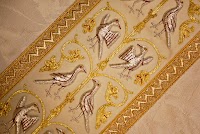 One of the most interesting projects of contemporary gothic revival in the first decade of the 21st century was no doubt Syon Abbey -- a Benedictine abbey located near Roanoke, Virginia. The project was executed by Ethan Anthony of the architectural firm, Cram and Ferguson …
One of the most interesting projects of contemporary gothic revival in the first decade of the 21st century was no doubt Syon Abbey -- a Benedictine abbey located near Roanoke, Virginia. The project was executed by Ethan Anthony of the architectural firm, Cram and Ferguson …
Our Advertising Partners
-
The global pandemic has disrupted the normal celebration of the Holy Week in Spain, where, for a second year, the government has forbidden t...
-
To the person who simply enjoys beautiful art and architecture, distinctions like "baroque" or "rococo" might seem overl...
-
We live in a very visual, image-based culture and, what's more, there is always lots of curiosity around the matter of traditional papal...
-
The earliest pictorial representations of the Baptism of the Lord were carved in stone, on Christian sarcophagi. Later, during the long Mid...
-
The mitre is one of the most recognizable symbols of prelates of the Church, specifically of bishops up to the Roman pontiff himself -- thou...
-
In a previous article we considered what the exterior of Old St. Peter's was like and today we will turn our attention to the interio...
Blog Archive
-
▼
2020
(252)
-
▼
April
(22)
- 21st Century English Medieval Revival: Syon Abbey ...
- Some Macabre Details from Torcello's Last Judgement
- One Hundred Silver Doves
- A Model Roman Altar
- Papal Master of Ceremonies: Monsignor Enrico Dante
- Ecclesiastical Textiles of Richard Norman Shaw (18...
- What Sits Underneath St. Peter's Basilica in Rome
- Sacristy Tips: The Traditional Way to Wear the Fascia
- An Early Eighteenth Century Antependium of St. Joh...
- Sacristy Tips: The Roman Method for Wearing a Roma...
- The Paschal Blessing of the "Agnus Dei" (Benedizio...
- The Shrine of Our Lady of Guadalupe in the USA: To...
- Connecting the Natural and Liturgical: Floriated V...
- Easter and the Bees
- Three Vestments for Good Friday
- Three Chasubles for Holy Thursday
- The "Seña" on Spy Wednesday
- Monsignor Richard.J. Schuler on Art, Music & Beaut...
- Eucharistic Utensils
- Liturgical Treasures from the Cathedral Museum of ...
- The Noble Simplicity of the Traditional Sanctuary ...
- Portable Altars in Malta
-
▼
April
(22)
Donate
Copyright ©
Liturgical Arts Journal | Powered by Blogger






































